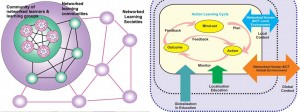 Unlimited, continuous improvement and successes are the aims of the learning community. Learning is a journey, and has intrinsic merit if moves on in the right direction, thus requiring frequent shifting in many things. Developing the right paradigm is most important of all. A new triplization paradigm of learning has been proposed and discussed largely in this article where triplization refers to the process including globalisation, localisation and individualisation.
Unlimited, continuous improvement and successes are the aims of the learning community. Learning is a journey, and has intrinsic merit if moves on in the right direction, thus requiring frequent shifting in many things. Developing the right paradigm is most important of all. A new triplization paradigm of learning has been proposed and discussed largely in this article where triplization refers to the process including globalisation, localisation and individualisation.
In facing the challenges of globalisation and international competitions, there seem three waves of educational reforms in different parts of the world, representing paradigm shifts in redefining the nature and effectiveness of learning, teaching and integration of Information and Communication Technology in education.
Three waves of educational reforms integrating ICT
Assuming that education is knowledge delivery and learning is mainly a process of students receiving knowledge and skills from their previous generation such as teachers and other senior people, the first wave of educational reforms introduced since the 1980s focused on enhancing ‘internal effectiveness’ of educational institutions. The role of ICT and other technological innovations in education aimed to improve the internal performance of educational institutions, particularly the methods and processes of teaching and learning.
In the 1990s, as a response to the worldwide success of marketisation and business management, the second wave of educational reforms came up which was mainly concerned with interface effectiveness of educational provision that was often determined in terms of stakeholders’ satisfaction and market
competitiveness. Implicitly or explicitly the role of integrating ICT in education was to add values to the educational service, enhance the marketability of educational provision, and ensure the process of learning, teaching, and schooling meeting stakeholders’ expectations. In the second wave, the greater satisfaction of stakeholders with ICTrich educational provision represents the greater effectiveness of integration of ICT in education. In facing the tremendous impacts of globalisation and knowledge economy at turn of the new century, people began to doubt if the initiatives of the first and second waves are sufficient for revitalising schooling and pedagogy so as to ensure that the younger generation can meet the challenges of rapid transformations in such a new era. In particular, even though the first and second waves of educational reforms emphasised the role of ICT in delivery of knowledge and satisfaction of stakeholders, both failed to address some key concerns of sustainable development of individuals and the society in the future, such as whether the application of ICT can contribute to learners’ sustainable developmentand effectiveness in future and whether ICT can be used to facilitate paradigm shift in learning and teaching in a fast changing context of globalisation. third wave of educational reforms focuses on future effectiveness of education, efined in terms of the relevance to the future development of individuals and the society as well as the relevance to the new paradigm of education concerning contextualised multiple intelligences (including technological, economical, social, political, cultural and learning intelligences) and triplization (an integration of globalisation, localisation and individualisation) in education (Cheng, 2005 in New paradigm for re-engineering education: Globalisation, localisation and individualisation). Differently from the first and second waves, the nature of learning in the third wave is to develop contextualised multiple intelligences (CMI) of learners for multiple and sustainable developments (including technological, economic, social, political, cultural and learning developments) in both local and global contexts. Paradigm Shift in Learning According to the previous research, there is a paradigm shift in learning from the traditional site-bounded paradigm to the new triplization paradigm of learning. In the traditional thinking as in the first wave, students’ learning is a reproduction process of the knowledge and manpower structure to sustain the existing society, particularly in the social nd economic aspects. But, in the new paradigm, learning should be borderless and characterised by individualisation, localisation, and globalisation with the support of ICT and networked environment. It is a triplization learning. Individualised Learning: Student is the centre of education process. Students’ learning should be facilitated to meet their needs and personal characteristics, and develop their potentials particularly contextualised multiple intelligence
(CMI) in an optimal way. Individualised and tailor-made programmes (including targets, content, methods, and schedules) with the support of ICT for different students are necessary and feasible. Students can be self-motivated and self-learning with appropriate guidance, ICT literacy, and
facilitation. Learning is a selfactualising, discovering, experiencing, and reflecting process. Since the information and knowledge are accumulated in an unbelievable speed but outdated very quickly, it is nearly impossible to make any sense if education is mainly to deliver skills and knowledge, particularly when tudents can find the knowledge and information easily with the help of information technology and Internet. Therefore, the focus of learning is on how to learn, think, and create. In order to sustain learning life-long, learning should be facilitated as enjoyable and selfrewarding. Localised and Globalised
Learning: Students’ learning should be facilitated in such a way such that local and global resources, support, expertise, and network can be brought in to maximise the opportunities for their CMI developments during learning process. Through localisation and globalisation, there are multiple sources for learning. Students can learn from multiple sources such as teachers, experts, peers, scholars and all types of experienced people inside and outside their schools, locally and globally, not limited to a small number of teachers in their own schools. Participation in local and international learning programmes (e.g. learning activities conducted in the local community; overseas study visits or language immersion) can help them achieve the related local and global utlook beyond schools. They are grouped and networked locally and internationally with the support of various types of ICT networks. It is expected that learning happens everywhere and is life-long. Education is just the preparation for a high-level life-long learning and discovery. Learning opportunities are unlimited. Students can maximise the opportunities for their learning from local and global exposures through Internet, web-based learning, videoconferencing, cross-cultural sharing, and different types of interactive and multi-media materials With thesupport of ICT and networking,
students can learn from world-class teachers, experts, peers, and learning materials from different parts of the world. In other words, their learning can be a world-class learning. New vision of teaching:With the paradigm shifts in learning, there should be a new vision of teaching that includes at least three major key components: (1) to facilitate students to experience paradigm shift towards the triplization learning; (2) to provide a triplised environment (including a networked human and IT environment) for students’ selflearning;
and (3) to develop students’ triplised independent learning ability and contextualised multiple intelligence.
 Learning in a networked human and ICT environment
Learning in a networked human and ICT environment
According to the new paradigm, students’ continuous independent learning and development of CMI should be globalised, localised and individualised with the support of ICT and various types of international and local networking. Mok and Cheng (A theory of self learning in a human and technological environment: Implications for education reforms, 2001) has proposed a theory of selflearning in a networked human and technology environment to show how students’ individualised self-learning can be motivated, sustained and optimised through the wide local and international support from the borderless and networked human and technological environment. This networked environment can create unlimited opportunities for students’ triplized learning because it re-defines and optimises (1) the boundary and nature of the learning context; (2) the composition of players involved in the learning process; (3) the format, speed and nature of communication and feedback to learning; and (4) the generation, management, sharing and utilization of knowledge during the learning process.
Paradigm shift in application of ICT
Given the paradigm shift in learning, here is also a corresponding paradigm shift in applying ICT in education, as discussed above. Since the traditional paradigm of the first and second waves emphasises delivering knowledge within the site boundary and satisfying the multiple stakeholders’ expectations in the local community, the role and effectiveness of ICT in education are very limited. But in the new paradigm, there is extensive application and integration of ICT in education that can create unlimited opportunities for students’ learning. The effectiveness of ICT in education is mainly based on the following considerations that are completely different from the traditional thinking: 1. How well can the application of CT help to globalise, localise and individualise students’ learning? 2. How well can the application of ICT maximise students’ learning opportunities through the locally and globally networked human and ICT environment and various innovative learning programmes? 3. How well can the application of CT ensure students’ learning to be sustainable as potentially life long? 4. How well can the application of ICT facilitate the development of students’ ability to triplicate their learning and development?
5. How well can the application of ICT facilitate the development of a CMI-pedagogical environment, in which students are immersed and inspired to be self-actualising and developing CMI themselves? The implications for paradigm shift in applying ICT in education are substantial. The effectiveness of
applying ICT depends mainly on hether they can facilitate students to develop themselves successfully in terms of CMI and ability for triplization in learning
























